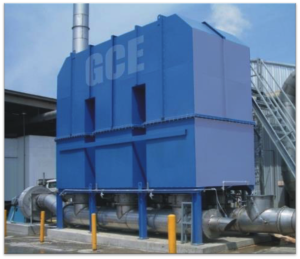Maximizing Use of Waste Heat:
GCES maximizes every reasonable effort to provide beneficial use of Waste Heat Recovery equipment (WHR) equipment with the supply of all high-temperature Air Pollution Control equipment devices. By implementing Waste Heat Recovery options a facility can greatly reduce operating costs and increase efficiencies.
Some possible options for Waste Heat use include:
- Heat Transfer Fluid
- Steam Production
- Boiler Feed Water
- Building Heat
- Process Supplemental Heating
So where do you start an investigation to determine if your existing or proposed new system is energy efficient? The investigation on existing equipment will require a technical person skilled in measuring or obtaining the pertinent data related to the equipment evaluation. With new equipment, it should be provided in the proposal or obtained during technical reviews of the planned project.
If you plan to perform an internal evaluation of the energy efficiency and potential waste heat recovery options with your existing process, be sure to consider the following process characteristics:
1. Define the process lines heat load distribution
Determining where the energy is going will help identify where efficiency can be improved. How much heat is going to:
- Substrate and coating?
- Solvent evaporation?
- Makeup air and exhaust?
Equally important, how much heat is available in exhaust solvents via recovery or combustion?
2. Define the solvent rate and range
How much variation exists in the solvent input rate for the product range produced? Factor in the amount of production run time on each product, e.g., a low solvent input rate may be a high percentage of your production. The line sizing and your process exhaust are likely based on the higher input rate product(s) produced.
3. Generate an accurate flow diagram for the process line being evaluated
Record the entire product input and output conditions that define your process. Obtain all the associated flow, temperature, pressure, installed and operating horsepower, etc., data vs. the product input data. This data-gathering process can expend a great deal of time and energy, but it is essential to getting results.
4. Identify payback opportunities
If you have the necessary skills and manpower within your organization to evaluate and implement energy savings programs, congratulations, there are benefits available to your bottom line. Another option is concluding your process has opportunities to save energy, but you need help! Consulting engineering firms or capital equipment manufacturing companies that offer additional engineering services may be the best way to gather the data and analyze the savings opportunities.
Heat Recovery Considerations
It is important to understand that as the efficiency of the primary heat recovery systems is increased, the amount of heat available for secondary recovery decreases. A well-designed primary heat recovery system may eliminate the need for any secondary system. The design goal for any new system should be to first optimize the primary heat recovery system. Secondary heat recovery requires the interconnection of two separate operating systems. It is important to thoroughly analyze the operating cycles of both the dryer and oxidizer through their entire range of operation. The dryer provides fuel to the oxidizer; the oxidizer provides heat to the dryer. If supply and demand are not balanced for all operating conditions, an auxiliary heat source may be required at the dryer. Generally, it is not recommended to over-fire the oxidizer to provide heat to the dryer.
This analysis gets even more complex when considering a tertiary heat recovery system. With primary and secondary recovery, the process requiring the heat operates on the same schedule as the process generating the heat. The tertiary recovery system may be providing plant heating or cooling, or energy to another process. Supply and demand are rarely balanced, so tertiary systems normally are considered supplemental.
Designing an efficient heat recovery system is not difficult. Waste heat sources are matched with potential users, and the appropriate heat transfer and control system is designed. However, determining the feasibility of a heat recovery system is difficult. Heat recovery feasibility is a financial decision. Energy savings must be balanced against capital, operating, and maintenance costs over the life of the system. Accurately quantifying these variables can be extremely difficult. A thorough analysis of potential heat sources and users is necessary. The skill and experience of the system designer are critical. Fluctuating utility prices and changing regulations complicate payback calculations. The technology of heat recovery is well developed. The art lies in the application.
For more information on primary heat recovery and secondary heat recovery please visit our blog.
GCES is dedicated to providing the best environmental equipment for your need. We will assist you in selecting equipment that takes into consideration equipment costs, operating costs, and pollution control results.
To know more, please check GCE Systems.

